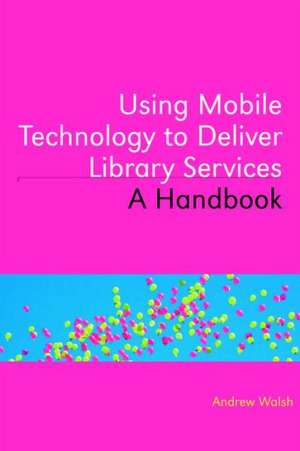Using Mobile Technology to Deliver Library Services: A Handbook
Autor Andrew Walshen Limba Engleză Paperback – 7 oct 2012
Preț: 687.78 lei
Preț vechi: 893.22 lei
-23% Nou
Puncte Express: 1032
Preț estimativ în valută:
131.64€ • 135.66$ • 111.14£
131.64€ • 135.66$ • 111.14£
Carte indisponibilă temporar
Doresc să fiu notificat când acest titlu va fi disponibil:
Se trimite...
Preluare comenzi: 021 569.72.76
Specificații
ISBN-13: 9780810887572
ISBN-10: 0810887576
Pagini: 160
Dimensiuni: 152 x 231 x 15 mm
Greutate: 0.28 kg
Ediția:New.
Editura: Scarecrow Press, Inc.
ISBN-10: 0810887576
Pagini: 160
Dimensiuni: 152 x 231 x 15 mm
Greutate: 0.28 kg
Ediția:New.
Editura: Scarecrow Press, Inc.
Notă biografică
Recenzii
In this handbook, Walsh (librarian, Univ. of Huddersfield, UK) provides a practical exploration of how mobile technologies can aid library service. After presenting an overview of the subject, he details a study examining the mobile services students want in an academic library context, effectively illustrating how the findings also apply to nonacademic contexts. He explores "fixed" information literacy (users search for and access resources in a "fixed" context with a suite of established tools) and "mobile" information literacy (users do not have a full suite of tools and are often doing more limited tasks using more limited resources). Examining how search behavior differs across devices helps determine the types of mobile options that might be most valuable for libraries. Walsh gives specific examples of how mobile technologies are being used, ranging from roving librarianship and applications in teaching to mobile use of ebooks, and discusses how such technologies can help with librarians' productivity and professional development. Each chapter includes case studies of real-world applications in various library contexts, including not just the UK, but also Canada, the States, and Australia. VERDICT Well written, clear, engaging, and applicable to many different types of libraries, this highly recommended work is a must-have for librarians wondering, "Is there an app for that?" Library Journal, Starred Review Walsh is an academic librarian at Huddersfield University who has written and presented widely on the application of mobile technologies within the library environment. This slim volume provides a primer in a wide range of mobile technologies and devices as well as chapters outlining the critical differences between traditional information literacies versus mobile information literacy and how library workers can make the most of mobile devices and technologies to increase productivity and flexibility in supporting users. Meticulously researched, each chapter is filled with useful case studies, along with extensive references and suggestions for further reading. Although the focus is primarily the application of mobile technologies in an academic library environment, the ideas outlined by the author are easily transferable to any library. As Walsh cautions in the final chapter, the most important consideration when introducing mobile technologies as a method of service delivery in the library is: What do your users want, and what can your staff deliver? The worst thing library professionals can do is rush headlong into a project that cannot be sustained and provides services of little use to patrons. Careful readers of this guide should easily be able to avoid that pitfall. Booklist
